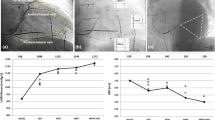Summary
Optimized uni- or biventricular pacing therapy improves left ventricular function in 80% of patients (responders) with wide QRS in surface ECG. Immediate improvement could be shown by an increase of LV dP/dt up to 28% and aortic pulse pressure up to 16%. Chronic improvement was documented by prolongation of the 6-minute-walk-test by 60 meters, an improvement of O2 uptake by 23% at exercise, and improvement of quality of life score and NYHA classification. This controlled study has shown for the first time a significant clinical improvement of congestive heart failure by pacing therapy in a selected group of patients. Conventional right ventricular stimulation is insufficient in this group of patients characterized by LBBB. These results support the hypothesis that optimized ventricular stimulation is an effective chronic therapy of congestive heart failure by improvement of left ventricular hemodynamics. Epicardial placement of the left ventricular electrodes in 50 patients was possible without operative and with low /2%) early mortality.
Zusammenfassung
Die optimierte uni- und biventrikuläre Schrittmachertherapie verbessert die linksventrikuläre Funktion bei 80% der Patienten (Responder) mit breitem QRS-Komplex sowohl akut durch eine Steigerung des linksventrikulären Drucks (LV dP/dt) um bis zu 28% und des Pulsdrucks um bis zu 16% als auch chronisch, gemessen an einer anhaltend verbesserten O2-Aufnahme in der Spiroergometrie um 23%, verbunden mit einer Verlängerung der Gehstrecke um 60 m im 6-Minuten-Gehtest, einer Verbesserung des Lebensqualitässcores und des NYHA-Stadiums. Die kontrollierte Studie zeigt damit erstmals eine signifikante klinische Verbesserung der Herzinsuffizienz durch Schrittmachertherapie bei einer ausgewählten Patientengruppe. Eine konventionelle rechtsventrikuläre Stimulation ist für diese, durch einen Linksschenkelblock charakterisierte und dominierte Patientengruppe unzureichend. Die Ergebnisse unterstützen die Hypothese, dass die optimierte ventrikuläre Stimulation eine effektive chronische Behandlungsmethode der Herzinsuffizienz durch Verbesserung der linksventrikulären Hämodynamik ist. Die epikardiale Platzierung der linksventrikulären Elektrode kann ohne operative und mit geringer Frühmortalität (2%) vorgenommen werden.
Similar content being viewed by others
Author information
Authors and Affiliations
Rights and permissions
About this article
Cite this article
Huth, C., Friedl, A., Klein, H. et al. Schrittmachertherapie der Herzinsuffizienz unter Berücksichtigung der Ergebnisse der PATH-CHF-Studie. Z Kardiol 90 (Suppl 1), I10–I15 (2001). https://doi.org/10.1007/s003920170053
Issue Date:
DOI: https://doi.org/10.1007/s003920170053




